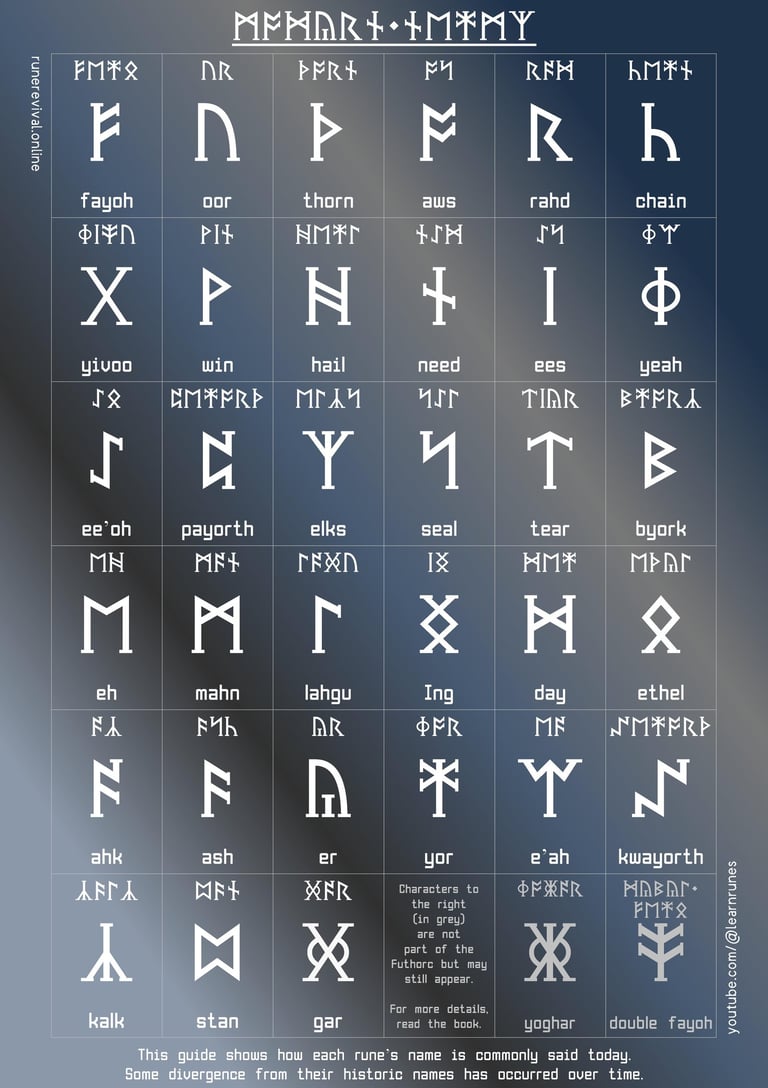
ᚱᚢᚾ᛫ᚱᛇᚠᚠᚪᛡᚠᚠᚣᛚ
Rune Revival

ᛒᛁᚠᚩᚱ᛫ᚦᛟ᛫ᛚᚫᛏᛁᚾ᛫ᚫᛚᚠᛟᛒᛖᛏ᛫ᚹᚩᛉ᛫ᛁᛗᛈᚩᚢᛉᛞ᛫᛫ᚩᚢᛚᛞ᛫ᛁᛝᚸᛚᛁᛋᚳ᛫ᚹᚩᛉ᛫ᚱᛁᛏᚾ᛫ᛁᚾ᛫ᚱᚢᚢᚾᛉ᛬ᚦᛟ᛫ᚫᛝᚸᛚᚩᚢ‐ᛋᚫᛣᛋᛟᚾ᛫ᛈᛇᛈᛚ᛫ᛒᛁᛚᛏ᛫ᛟᛈᚩᚾ᛫ᚦᛟ᛫ᛖᛡᚾᚳᚾᛏ᛫ᚱᚢᚢᚾᛁᛣ᛫ᛋᛣᚱᛁᛈᛏ᛫ᛟᚠᚠ᛫ᛖᛚᛞᛟᚱ᛫ᚠᚢᚦᚫᚱᛣ᛫ᛏ᛫ᛣᚱᛇᛖᛡᛏ᛫ᚦᛟ᛫ᚫᛝᚸᛚᚩᚢ‐ᛋᚫᛣᛋᛟᚾ᛫ᚠᚢᚦᚩᚱᚳ᛬ᚦᛁᛋ᛫ᚾᛖᛡᛏᛁᚠᚠ᛫ᚱᚪᛡᛏᛁᛝ᛫ᛋᛁᛥᛗ᛫ᚹᚩᛉ᛫ᛞᚠᚠᛖᛚᛟᛈᛏ᛫ᛋᛈᛟᛋᛁᚠᛁᛣᛚᛇ᛫ᚠᚩᚱ᛫ᚦᛟ᛫ᛁᛝᚸᛚᛁᛋᚳ᛫ᛚᚫᛝᚸᚹᛁᚷ᛬ᚪᚾᚠᚩᚱᚳᛟᚾᛟᛏᛚᛇ᛫᛫ᚹᛁᚦ᛫ᛋᚪᛗ᛫ᛋᛗᚩᚩᛚ᛫ᛁᛣᛋᛖᛈᛋᚳᚾᛉ᛫᛫ᛁᛏ᛫ᛚᚪᚱᚷᛚᛇ᛫ᚠᛖᛚ᛫ᚣᛏ᛫ᛟᚠᚠ᛫ᛄᚢᚢᛋ᛫ᛟ᛫ᚦᚣᛉᛟᚾᛞ᛫ᛄᛠᚱᛉ᛫ᛟᚸᚩᚢ᛬ᛒᚪᛏ᛫ᚩᚩᛚᚦᚩᚢ᛫ᚣᚱ᛫ᛚᚫᛝᚸᚹᛁᚷ᛫ᚻᚫᛉ᛫ᚳᛖᛡᚾᚷᛞ᛫ᛟ᛫ᛚᚩᛏ᛫ᛋᛁᚾᛋ᛫ᚦᛖᚾ᛫᛫ᚱᚢᚢᚾᛉ᛫ᛣᚫᚾ᛫ᛥᛁᛚ᛫ᛒᛇ᛫ᛄᚢᚢᛉᛞ᛫ᛏ᛫ᚱᚪᛡᛏ᛫ᛁᛝᚸᛚᛁᛋᚳ᛫ᛏᛟᛞᛖᛡ᛬ᚹᚩᚾᛏ᛫ᛏ᛫ᛚᛟᚱᚾ᛫ᚻᚣ?ᚦᛖᚾ᛫ᛄᚢᛌᚠᚠ᛫ᛣᚪᛗ᛫ᛏ᛫ᚦᛟ᛫ᚱᚪᛡᛏ᛫ᛈᛚᛖᛡᛋ᛬


Before the Latin alphabet was imposed, Old English was written in runes. The Anglo-Saxon people built upon the ancient runic script of Elder Futhark to create the Anglo-Saxon Futhorc. This native writing system was developed specifically for the English language. Unfortunately, with some small exceptions, it largely fell out of use a thousand years ago. But although our language has changed a lot since then, runes can still be used to write English today. Want to learn how? Then you've come to the right place.

«ᚦᚣ᛫ᛋᚫᛞᚣᛥ᛫ᚦᛁᛝ᛫ᚣᛒᚫᚢᛏ᛫ᛖᚾᛇ᛫ᛗᚫᚾ᛫ᛁᛉ᛫ᚦᚫᛏ᛫ᚻᛇ᛫ᛒᛇ᛫ᛁᚸᚾᚣᚱᚣᚾᛏ᛫᛫ᚫᚾᛞ᛫ᚦᚣ᛫ᛗᛟᛥ᛫ᛁᛣᛋᚪᛡᛏᛁᛝ᛫ᚦᛁᛝ᛫ᛁᛉ᛫ᚦᚫᛏ᛫ᚻᛇ᛫ᚾᛟᛉ᛬»
–ᛣᛁᛝ᛫ᚫᛚᚠᚱᚣᛞ᛫ᚦᚣ᛫ᚸᚱᛖᛡᛏ


"The saddest thing about any man is that he be ignorant, and the most exciting thing is that he knows."
– King Alfred the Great
